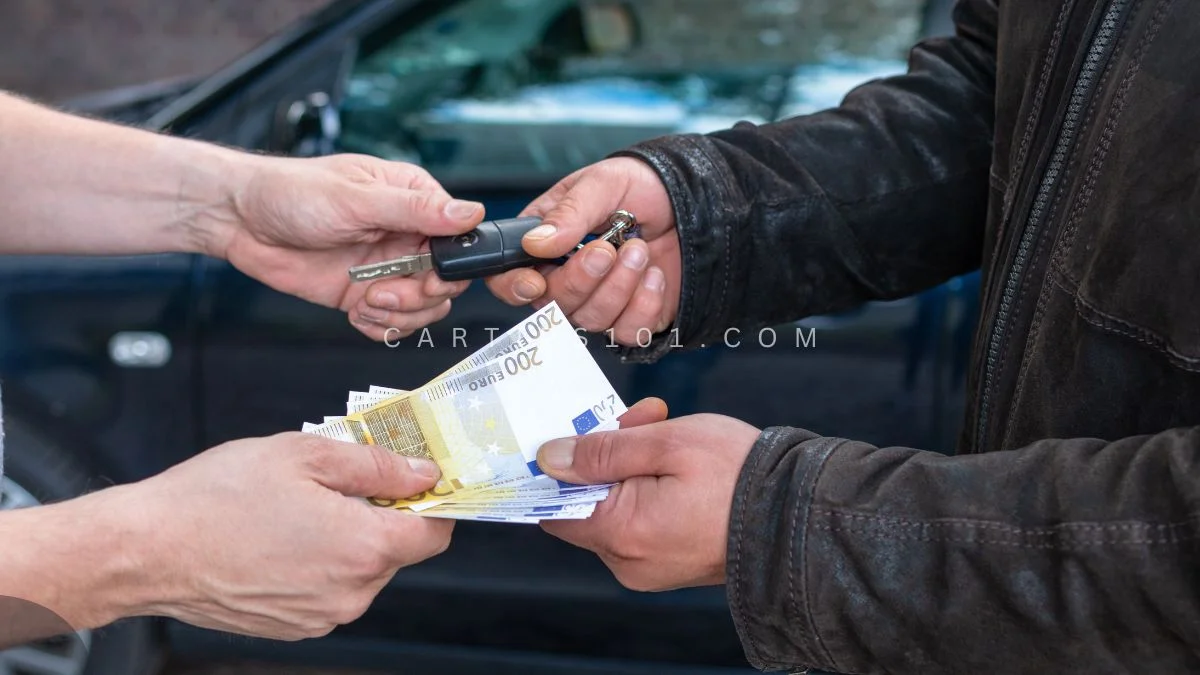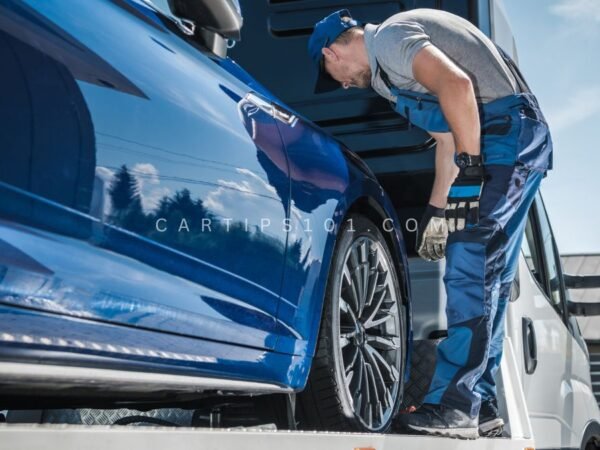When you finance a car, understanding who holds the title is crucial. Typically, the lender retains the title until the loan is paid in full. This means they have a legal right to the vehicle as collateral for the loan.
The title is a document that proves ownership of the car. When you finance a car, you don't fully own it until the last payment is made. The lender, such as a bank or credit union, holds the title to ensure they have a claim to the vehicle if you default on the loan.
Examples:
- Bank Loans: When you get a loan from a bank, the bank keeps the title until the loan is completely repaid.
- Credit Union Loans: Similar to banks, credit unions hold the title while you pay off your loan.
- Dealership Financing: If you finance through a dealership, they typically work with a financial institution that holds the title.
Tips:
- Read Your Loan Agreement Carefully: Always check the terms about who holds the title.
- Pay Off Your Loan Early if Possible: This can help you gain full ownership sooner.
- Keep Track of Your Payments: Ensure that your payments are recorded correctly to avoid disputes about the title.
| Scenario | Who Holds the Title? |
|---|---|
| Financing through a bank | Bank holds the title |
| Financing through a dealership | Dealership's financial institution holds the title |
| Paid in full | You receive the title |
Lender's Role in Car Title
The lender's role in the car title process is crucial. They maintain the title as collateral for the loan, which means they have a financial interest in the vehicle. If you took out a loan to purchase the car, there is a lien on the title, and the bank may hold the title until your loan is fully paid off.
Once you have made all the payments and settled the loan, you can initiate the process to remove the lien on the title. This typically involves following your state's Bureau of Motor Vehicles (BMV) or Department of Motor Vehicles (DMV) procedures to get the title transferred into your name (Progressive).
| Lender's Responsibilities | Description |
|---|---|
| Hold Title | The lender keeps the title until the loan is paid. |
| Lien Placement | A lien is placed on the title to secure the loan. |
Understanding these aspects of car finance titles will help you navigate the financing process more effectively, ensuring that you are informed about your rights and responsibilities as a car owner.
Car Title Process
Understanding the car title process is essential when financing a vehicle. This process varies significantly depending on whether you reside in a title holding state or a non-title holding state.
Title Holding States
In title holding states, the lienholder (typically the bank or finance company) is listed as the primary owner on the car title. They retain the title until the loan is fully paid off. Once you pay off the car, the lienholder provides a notification of the ownership change. This can occur through either the Electronic Lien and Title (ELT) system or through manual notification methods (Progressive).
The time it takes to receive your title after paying off the loan can range from two to six weeks, depending on the specific processes of your state and the lienholder's notification methods.
| Steps in Title Holding States | Duration |
|---|---|
| Notification of loan payoff | Varies |
| Title processing after payoff | 2 - 6 weeks |
Non-Title Holding States
In non-title holding states, you may possess the title even while still paying off your auto loan. However, legally, you do not own the vehicle until the loan is paid in full. The lienholder retains their claim until you settle the remaining balance.
If you are in a non-title holding state and still owe on your loan, you cannot change the title to reflect your name as the owner. The only way to obtain the title with your name as the legal owner is by paying off the loan completely.
| Steps in Non-Title Holding States | Duration |
|---|---|
| Possession of title while financing | Yes |
| Legal ownership status | Until loan is paid off |
Understanding these processes is crucial for anyone financing a car, as it helps clarify who holds legal ownership and what steps are necessary to transition to full ownership of the vehicle.
Transitioning Ownership
When you finance a car, understanding the process of transitioning ownership is essential. This includes paying off the loan and obtaining the car title.
Paying Off the Loan
To gain full ownership of your financed vehicle, you must pay off the loan in its entirety. When you finance a car through a dealership, you will not receive the title until the loan is completely paid off. However, if the financing comes from a private party loan, you will get the title once the loan is finalized.
Once you pay off the loan and have a zero balance, you become the legal owner of the vehicle. At this stage, the lien-holder will be removed from the title, and your name will be added as the owner (Car and Driver).
| Step | Action |
|---|---|
| 1 | Pay off the remaining balance of your auto loan. |
| 2 | Confirm the loan payoff with your lender. |
| 3 | Wait for the lien-holder to be removed from the title. |
Obtaining the Car Title
After paying off your loan, you will need to obtain the car title. The process can vary based on the state you live in and the lender's procedures. Generally, it takes between two to six weeks to receive the title after the loan is paid off. This timeframe depends on the state's processing times and the lienholder's notification of the loan payoff.
Once you receive the title, it is important to notify your auto insurance company about the change in ownership. Lienholders are typically listed on auto insurance policies and can be removed once the loan is paid off. While this change might not directly affect your insurance premium, it could lead to adjustments in coverage.
| Timeframe | Action |
|---|---|
| 0-2 weeks | Confirm loan payoff with lender and initiate title transfer. |
| 2-6 weeks | Wait for title to arrive from the lienholder or state DMV. |
| After receiving title | Update your insurance policy to reflect new ownership. |
Understanding these steps ensures a smoother transition to full ownership of your financed vehicle.
Selling a Financed Car
Selling a financed car involves specific steps and legal considerations. Understanding these processes ensures that you can successfully transfer ownership while complying with the necessary regulations.
Transfer Process
If you want to sell the car before it’s fully paid off, you will need the title to complete the transaction. The general process includes:
- Contacting Your Lender: Reach out to your lender to discuss the outstanding loan balance. They can provide the exact amount needed to pay off the loan.
- Selling the Vehicle: You can sell your vehicle and use the profits to pay off the loan. Once the loan is settled, the lender will release the lien on the car.
- Obtaining the Title: After paying off the loan, you will need to request a title transfer from your lender. This step ensures that the title is in your name, allowing you to transfer it to the new owner (Car and Driver).
- Transferring the Title: Once you have the title, you can complete the sale by transferring it to the new owner. This step is crucial, as selling a car without a title may lead to complications.
| Step | Action |
|---|---|
| 1 | Contact your lender for the loan balance. |
| 2 | Sell the vehicle and use profits to pay off the loan. |
| 3 | Request the title from your lender after loan payment. |
| 4 | Transfer the title to the new owner. |
Legal Implications
When selling a financed vehicle, there are legal implications to consider. If a vehicle has a lien on it due to an existing loan, the lender must be paid off before releasing the lien and transferring the title to the new owner. Here are some important legal aspects to keep in mind:
- Ownership Status: If you’re still paying off your auto loan, you do not legally own the vehicle, even if you have possession of the title in a non-title holding state. The title is held by the lender until the loan is paid off.
- Potential Complications: Purchasing a car without a title can lead to issues such as tax evasion by the seller, difficulties in transferring the title and registering the car, or unknowingly buying a vehicle with a branded title or a lien against it.
- Legal Ownership: Once your loan is paid off and you have a zero balance, you become the legal owner of the vehicle. At this point, the lien-holder will be removed from the title and your name will be added as the owner.
Understanding these processes and legalities will help you navigate the sale of your financed car smoothly and avoid potential issues.
Additional Considerations
Insurance and Ownership
When financing a car, understanding the relationship between insurance and ownership is crucial. Legally, the vehicle belongs to whoever is listed on the car title as the owner or joint owner, which may include the lienholder if the car is currently financed.
If you pay off your car loan, it is essential to inform your auto insurance company about the change in ownership. Lienholders are typically listed on auto insurance policies and can be removed once the loan is settled. This change may not directly affect your insurance premium, but it could lead to adjustments in coverage.
It is advisable to notify your auto insurance company about the change in ownership even before receiving the new title. Dropping certain coverages, such as comprehensive and collision, which were required by the lienholder, may lower your car insurance premium.
| Change in Ownership | Action Required |
|---|---|
| Loan Paid Off | Inform auto insurance company |
| Remove Lienholder | Update insurance policy |
| Adjust Coverage | Consider dropping unnecessary coverages |
Lease vs. Ownership
Understanding the differences between leasing and owning a vehicle is vital for making informed financial decisions. When you lease a car, you are essentially renting it for a specified period, typically two to three years. Ownership, on the other hand, means that you have purchased the vehicle outright, which allows for greater freedom regarding modifications and usage.
In a lease agreement, the leasing company retains ownership of the vehicle, and you are responsible for making monthly payments. At the end of the lease term, you may have the option to purchase the car or return it to the leasing company.
| Aspect | Leasing | Ownership |
|---|---|---|
| Title Holder | Leasing company | You |
| Monthly Payments | Typically lower | Generally higher |
| Modifications | Restricted | Allowed |
| End of Term Options | Return or buy | Keep or sell |
Understanding these distinctions can help you determine which option best suits your financial situation and lifestyle.
State-Specific Regulations
Understanding the regulations that govern car titles is essential when financing a vehicle. Different states have unique requirements regarding emissions tests, inspections, and the process for removing liens and transferring titles.
Emissions and Inspections
When transferring the title of a vehicle to a new state, some states may require an emissions test, a safety inspection, or both before granting the title and registration to an out-of-state vehicle. Additionally, they may ask for physical verification of the vehicle identification number.
| State Requirement | Emissions Test | Safety Inspection | VIN Verification |
|---|---|---|---|
| California | Yes | Yes | Yes |
| Texas | Yes | No | Yes |
| New York | Yes | Yes | Yes |
| Florida | No | No | Yes |
| Ohio | No | Yes | Yes |
Make sure to check your specific state regulations for precise requirements.
Removing Liens and Transferring Titles
If a vehicle has a lien due to an existing loan, the lender must be fully paid off before releasing the lien and transferring the title to the new owner (Schumacher Used).
Once you pay off your auto loan, the lien holder must notify your state’s Department of Motor Vehicles (DMV). The process can differ based on whether you live in a title-holding or non-title-holding state. In a title-holding state, you are responsible for updating your car title with the DMV or other state office. Your lender will send you a lien release in states that require you to file to obtain your title.
| State Type | Notification Process | Timeframe |
|---|---|---|
| Title-Holding State | You must file for title update | Expect within 30 days |
| Non-Title-Holding State | DMV handles automatically | 2 to 6 weeks |
In a non-title-holding state, the DMV or other state office will send the updated title directly to you once notified by the lender. The process is generally straightforward, but maintaining communication with your lender is essential to ensure timely completion.
Final Thoughts: When Financing a Car, Who Has the Title?
Understanding who holds the title when financing a car is important for both your financial planning and peace of mind. Remember, the lender usually keeps the title until the loan is fully paid. This ensures they have a legal claim to the vehicle if you fail to meet your obligations. Once the loan is paid off, the title is transferred to your name, giving you full ownership. Always read your loan agreement carefully and keep track of your payments to avoid any surprises.
FAQs about When Financing a Car, Who Has the Title?
Q: Does the lender keep the car title when financing a vehicle?
A: Yes, when you finance a car, the lender typically retains the title until the loan is fully paid off. This serves as a form of security or collateral for the loan.
Q: What happens to the title when I pay off my car loan?
A: Once the car loan is paid off, the lender releases the lien on the car, and the title is transferred to your name. This means you now have full ownership of the vehicle.
Q: Can I sell my car if I’m still financing it?
A: Yes, but the process is more complicated. You need to pay off the remaining loan balance to get the title from the lender before selling. Alternatively, the buyer can pay the lender directly, but this requires coordination with the lender.
Q: How do I know if there is a lien on my car title?
A: You can check with your state's Department of Motor Vehicles (DMV) or look at the car title document itself. If there is a lien, the lienholder's information will be listed on the title.
Q: What’s the difference between a lienholder and the car owner?
A: The car owner is the person who has purchased the vehicle, while the lienholder is the entity that provided financing and holds the title until the loan is paid off. The owner has possession of the vehicle, but the lienholder has a legal claim to it.
Q: Can I refinance my car while the lender holds the title?
A: Yes, you can refinance your car. The new lender will pay off the existing loan and take over the title until the new loan is paid off.
Image Source: Paid image from CANVA





